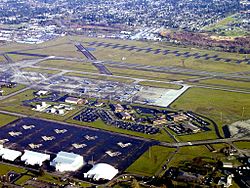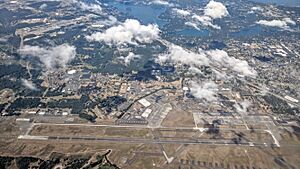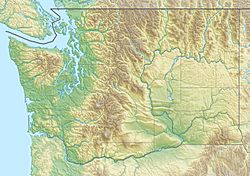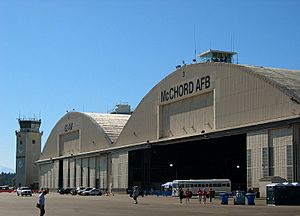McChord Field facts for kids
Quick facts for kids McChord Air Force Base |
|||||||||
|---|---|---|---|---|---|---|---|---|---|
| Near Lakewood, Washington in the United States of America | |||||||||

Aerial view of McChord AFB during 2003.
|
|||||||||
| Coordinates | 47°08′51″N 122°28′46″W / 47.14750°N 122.47944°W | ||||||||
| Type | US Air Force Base | ||||||||
| Site information | |||||||||
| Owner | Department of Defense | ||||||||
| Operator | United States Air Force | ||||||||
| Site history | |||||||||
| Built | 1927 (as Tacoma Field) | ||||||||
| In use | 1927 – 2010 | ||||||||
| Fate | Merged in 2010 to become an element of Joint Base Lewis–McChord | ||||||||
| Airfield information | |||||||||
| Identifiers | IATA: TCM, ICAO: KTCM, FAA LID: TCM | ||||||||
| Elevation | 98.1 metres (322 ft) AMSL | ||||||||
|
|||||||||
McChord Field is a U.S. Air Force base located in Pierce County, Washington, in the northwest United States. It is often still called McChord Air Force Base. The base is south of Tacoma. It is home to the 62nd Airlift Wing, which is part of the Air Mobility Command. Their main job is to move important supplies and people by air all over the world.
On February 1, 2010, McChord Air Force Base joined with the U.S. Army's Fort Lewis. Together, they became Joint Base Lewis-McChord. This change was made to combine resources and improve how the military operates. It also helps save money for taxpayers.
Contents
The 62nd Airlift Wing: Global Missions
The 62nd Airlift Wing (62 AW) is the main unit at McChord Field. It has over 7,200 military and civilian members. This wing helps with combat and humanitarian missions around the world. Their aircraft fly global missions, including training for airdrops. They also help resupply missions in Antarctica.
Wing Components and Aircraft
The 62nd Operations Group flies the large C-17 Globemaster III transport planes from McChord Field. This group includes three airlift squadrons and an Operations Support Squadron.
- 4th Airlift Squadron
- 7th Airlift Squadron
- 8th Airlift Squadron
Other important parts of the wing are the 62nd Maintenance Group, 62nd Comptroller Squadron, and 62nd Medical Squadron.
Other Units at McChord Field
Several other important units are also based at McChord Field:
- 446th Airlift Wing (Air Force Reserve Command)
- Western Air Defense Sector
- 22nd Special Tactics Squadron
- 262nd Cyberspace Operations Squadron
- 361st Recruiting Squadron
- 373d Training Squadron
McChord Air Museum
The McChord Air Museum is run by the McChord Air Museum Foundation. It displays 17 aircraft and many items that show the history of the airbase.
History of McChord Field
Early Days and Naming
In 1917, people in Pierce County voted to buy land for a military base. This land became Camp Lewis, later known as Fort Lewis. Ten years later, in 1927, another vote helped create an airfield near the base. This airfield, called Tacoma Field, opened on March 14, 1930.
On February 28, 1938, the airfield became part of the federal government. On July 3, 1940, it was renamed McChord Field. This was to honor Colonel William Caldwell McChord. He was a military aviator who died in a plane crash in 1937. McChord Field grew to cover about 3,000 acres. In 1947, it became independent from Fort Lewis and was named McChord Air Force Base.
McChord's Role in World War II
In 1940, McChord Field became a key base for defending the Pacific Northwest. The 17th Bombardment Group moved there with their B-18 Bolo bombers.
After the attack on Pearl Harbor in December 1941, the 17th Bombardment Group flew patrols to find submarines. They used the new B-25 Mitchell bombers. On December 24, 1941, one of their B-25s dropped bombs on a Japanese submarine. This was a first for the B-25. The 17th Bomb Group later moved to South Carolina. Crews from this group were chosen for the famous Doolittle Raid on Japan in April 1942.
After the 17th Bomb Group left, McChord Field focused on training. It helped train units and crews for bomber, fighter, and reconnaissance missions. The Second Air Force, based at McChord, trained many B-17 Flying Fortress and B-24 Liberator bomber groups. These groups then went to fight in different parts of the world.
Later in the war, McChord also helped train B-29 Superfortress bomber groups. These very large bombers were used by the Twentieth Air Force. McChord also had large facilities for aircraft maintenance. They modified P-39 Airacobra planes that were sent to Russia.
After the war in Europe ended in May 1945, McChord helped move thousands of troops. These troops were coming from Europe and going to the Pacific. This was in preparation for a planned invasion of Japan. However, the atomic bombings of Hiroshima and Nagasaki in August 1945 led to Japan's surrender. This meant the invasion was not needed.
The Cold War Era
In 1945, McChord was made a permanent military station. In 1948, it was officially renamed McChord Air Force Base.
Air Defense Command
From 1946, McChord's job was to defend the United States from air attacks. During the Cold War, many fighter planes and radar units were based there. The 25th Air Division was headquartered at McChord from 1951 to 1990.
The 325th Fighter Group flew F-82F Twin Mustang planes from McChord between 1948 and 1950. These were the first fighter planes designed for air defense after World War II. Other fighter squadrons also used McChord.
McChord was also one of the first places to have a permanent air defense radar network. Radars became active in 1950. In 1958, a Semi Automatic Ground Environment (SAGE) Data Center was built at McChord. The SAGE system linked radar stations to a central computer. This system was designed to give early warning of a Soviet nuclear attack. The SAGE system at McChord was active until 1983, when newer technology made it old-fashioned.
Today, the Western Air Defense Sector (WADS) is a major unit at McChord. WADS is one of two groups that protect the airspace over the United States. It is staffed by members of the Washington Air National Guard and the Royal Canadian Air Force. WADS works with North American Aerospace Defense Command (NORAD).
Military Airlift Command
In 1947, the 62nd Troop Carrier Group moved to McChord Field. This group was part of the new 62nd Troop Carrier Wing. They flew Curtiss C-46 Commando planes. In 1948, the 62nd Wing helped with the famous Berlin Airlift. Over 100 people from McChord went to Europe to help move supplies.
In 1949, the 62nd Wing received its first Douglas C-54 Skymaster planes. By 1950, they were flying the larger Douglas C-124 Globemaster II. During the Korean War (1952-1953), the 62nd airlifted troops, medical supplies, and equipment to the Far East. In 1954, they flew around the world to transport French troops to Dien Bien Phu.
From 1955 to 1957, the 62nd Wing flew missions to the Arctic. They carried millions of pounds of supplies to build the Distant Early Warning Line (DEW Line). This chain of radar stations was built to detect incoming Soviet missiles and bombers. The 62nd Wing continued to resupply the DEW Line stations until 1969.
In 1960, the 62nd Wing helped transport United Nations troops and supplies to the Congo. From 1963 to 1971, the wing was responsible for moving nuclear weapons and related equipment worldwide.
In 1968, McChord AFB became a base for the Military Airlift Command (MAC). It was one of three MAC bases in the western U.S. that flew the Lockheed C-141 Starlifter. In 1975, the Lockheed C-130 Hercules planes were also moved to MAC. This meant the 62nd Wing could do more types of airlift missions.
In 1980, after the eruption of Mount St. Helens, a C-130 crew from McChord helped with communications during the search for survivors. In 1988, McChord helped fight the large Yellowstone National Park forest fires. They carried troops from Fort Lewis to the fire areas.
In 1991, McChord helped evacuate Clark Air Base in the Philippines due to the eruption of Mount Pinatubo. The first plane of evacuees arrived at McChord on June 18. In 1992, the Military Airlift Command was changed to the Air Mobility Command. McChord became an Air Mobility Command base. In November 1992, two McChord C-141 Starlifters crashed in mid-air during a training mission. All 13 crew members died.
From the 1990s to Today
As the C-141 planes were retired in the 1990s, they were replaced by the C-17 Globemaster III. McChord AFB and the 62nd Airlift Wing were the second base to receive this new aircraft for active duty.
McChord has hosted the Air Mobility Rodeo several times, including in 1998, 2005, 2007, and 2009. This event is a competition for air mobility crews from around the world.
On February 1, 2010, McChord Field officially joined with Fort Lewis to become Joint Base Lewis-McChord.
Like most U.S. military bases, McChord is usually closed to the public. However, they do have an annual Open House where people can visit.
The McChord Field Historic District was added to the U.S. National Register of Historic Places in 2008.
Geography and Population

McChord Field covers about 15 square kilometers (5.8 square miles). It is next to Lakewood, about 1.6 kilometers (1 mile) south of Tacoma. It is also about 64 kilometers (40 miles) south of Seattle.
McChord Field is a census-designated place (CDP). In the year 2000, its population was 4,096 people.
Population Details
In 2000, there were 4,096 people living on the base. There were 1,004 households, and 978 of them were families. Most households (77.7%) had children under 18 living with them. About 89.9% were married couples.
The population was quite young. About 36.3% were under 18 years old. The median age was 22 years. For every 100 females, there were about 127 males.
The average income for a household on the base was $35,319. For families, the median income was $35,205.
Images for kids
-
McChord Main Gate in the late 1940s or early 1950s. Mount Rainier is in the background.







